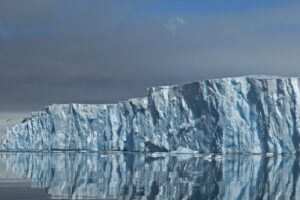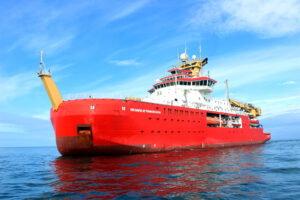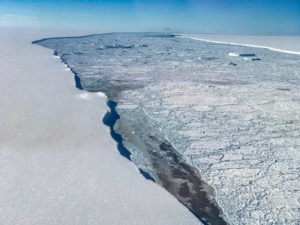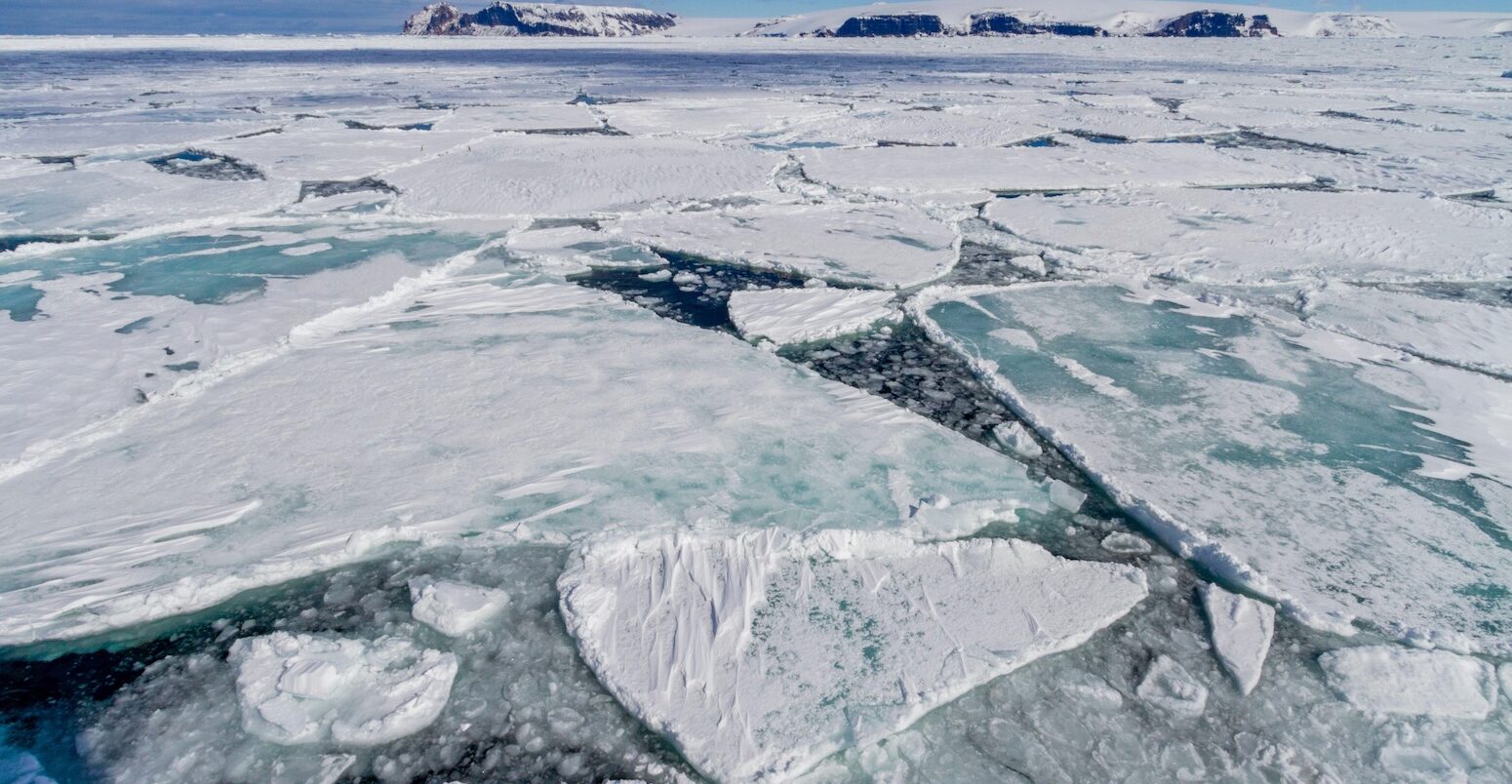
Antarctic sea ice maximum in 2024 is ‘second lowest’ on record
Ayesha Tandon
10.04.24Ayesha Tandon
04.10.2024 | 1:50pmAntarctic sea ice has reached its maximum extent for the year, clocking in at the second lowest in a record stretching back to 1979, according to provisional data from the US National Snow and Ice Data Centre (NSIDC).
Over the past two years, Antarctic sea ice has been “way outside anything we have witnessed in our satellite record for their winter months”, an expert tells Carbon Brief.
Meanwhile, at the Earth’s other pole, the Arctic reached its summer minimum extent on 11 September, ranking as the seventh lowest on record, according to the NSIDC.
The organisation notes that “the last 18 years are the lowest 18 Arctic sea ice extents in the satellite record”.
The combination of below-average Arctic and Antarctic sea ice extents means that global sea ice extent has been at near-record lows over the past six months.
Antarctic maximum
For decades, scientists have been using satellite data to track the annual cycle of sea ice growth and melt at the world’s poles. This is a key way to monitor the “health” of sea ice in both the Arctic and Antarctic.
This year, Antarctic sea ice extent reached its annual maximum extent of 17.2m square kilometres (km2) on 19 September, according to the NSIDC. This is the second lowest in a satellite record stretching back 46 years, and 1.6m km2 smaller than the 1981-2010 average maximum, the NSIDC notes.
However, the NSIDC cautions that there is “some uncertainty in the estimate and date of the maximum because of an outage in the input source data” over 12-18 September.
Dr Zack Labe is a research physical scientist at NOAA’s Geophysical Fluid Dynamics Laboratory. He tells Carbon Brief that there is ongoing research in the polar community to understand whether Antarctic sea ice is undergoing a “regime shift”.
He adds that the past two years have been “way outside anything we have witnessed in our satellite record for their winter months” for Antarctic sea ice.
For example, Dr Ariaan Purich – from the school of Earth, atmosphere and environment at Monash University – explains to Carbon Brief:
“Our research suggests ocean warming has been important in pushing sea ice into this low-coverage state, and we also see preliminary indications of changed sea ice behaviour, suggesting that the underlying processes controlling Antarctic sea ice coverage may have altered.”
Global sea ice extent – a metric that combines Arctic and Antarctic sea ice extent – is currently tracking near the record low extent set last year.
The graphic below shows global sea ice extent over 1978-2024, where red indicates the 2024 extent and shades of blue indicate different years over 1978-2023 (darker colours indicate more recent years).
Labe tells Carbon Brief that global sea ice extent is an “unconventional metric”, but says it “really summarises the state of polar climate right now, which is that sea ice is unusually low all across the high latitude regions of our planet”.
Record-breaking Antarctic season
The Antarctic has seen a record-breaking year. In September 2023, Antarctic sea ice reached a new all-time low maximum extent, sparking widespread media attention. In the year that followed, sea ice extent has since continued to track near record lows.
On 20 February 2024, the Antarctic hit its annual minimum, tying with 2022 for the second-lowest minimum in the 46-year satellite record. Dr Mark Serreze, director of the NSIDC told Carbon Brief at the time that more warm ocean water was reaching the surface, melting ice and keeping more ice from forming.
He said that we “must wait and see” whether this is a “temporary effect” or if the Antarctic has entered a “new regime”.
Antarctic sea ice extent “expanded slowly” throughout March, and ended the month tied with several other years for third-lowest sea ice extent on record for the time of year, according to the NSIDC.
Throughout April, Antarctic sea ice extent continued to grow “relatively uniformly”. The continent saw temperatures of 3-5C above average in the west, while in the east, temperatures were 4-7C below average, the NSIDC adds.
Throughout May 2024, the rate of growth was slow relative to the 1981-2010 average, but “still much faster than last year”, the NSIDC says. And into June, Antarctic sea ice continued to track “well below all previous years except for 2023”, it adds.
The NSIDC finds that by the end of June, sea ice extent was more than 2m km2 below the 1981-2010 average, but still 500,000km2 above the exceptionally-low 2023 extent for the time of year.
By late July, Antarctic sea ice extent was “very close to the levels” seen in 2023. By the end of July, Antarctic sea ice was more than 2.1m km2 below the 1981-2010 average, and 190,000 km2 above 2023 levels, the NSIDC says.
The graphic below shows Antarctic sea ice extent between 1978 and 2024, where red indicates the 2024 extent and shades of blue indicate different years over 1978-2023 (darker colours indicate more recent years).
After slow growth from May to July, Antarctic sea ice began to “rapidly expand” in August, according to the NSIDC. It says “ice growth for the first two weeks of August was 1.5m km2 per day, among the fastest ice growth rates seen in the 46-year record for this time of year”.
However, growth “stalled” over 16-25 August and, by the end of the month, Antarctic sea ice extent stood at 16.86m km2 – the second lowest in the satellite record for that date ,the NSIDC says.
It notes that sea ice extent is “particularly low in the far eastern Weddell Sea, the south-west Indian Ocean and in the Amundsen Sea”.
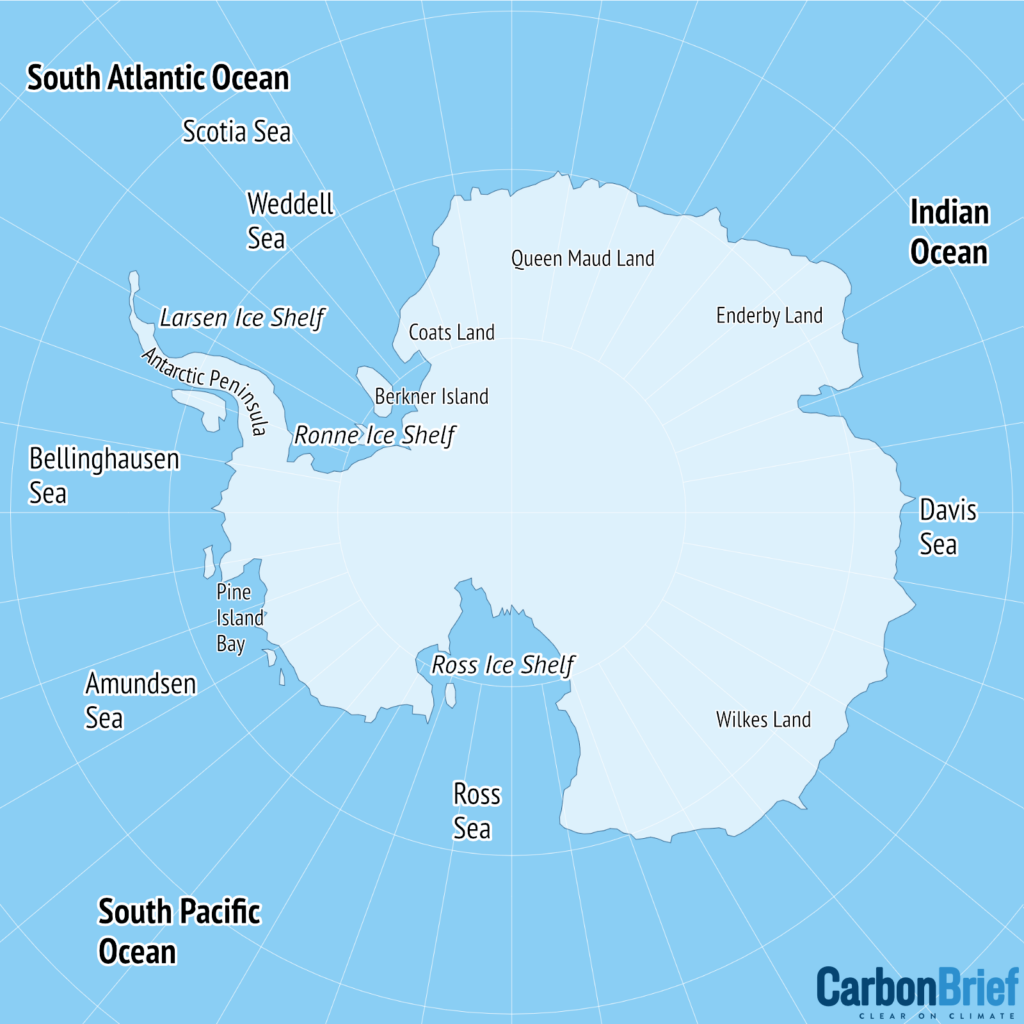
Arctic minimum
At the other end of the world, Arctic sea ice extent has been melting towards its annual minimum for the past six months. It reached its minimum in September, and has now begun to grow again.
Back on 14 March, the Arctic hit its annual maximum, which was the 14th lowest in the satellite record. The NSIDC finds that despite favourable winds that encouraged sea ice formation, the maximum sea ice extent was 640,000km2 smaller than the 1981-2010 average maximum.
As temperatures warmed in the Arctic, sea ice continued to melt. By the start of April 2024, Arctic sea ice extent had dropped by about 278,000km2 below the March maximum, the NSIDC says.
April sea ice loss in the Arctic proceeded at a near-average rate overall, with most ice loss in the Bering Sea and Sea of Okhotsk, according to the NSIDC. The average Arctic sea ice extent for April 2024 was 14.12m km2, placing it 16th lowest in the satellite record.
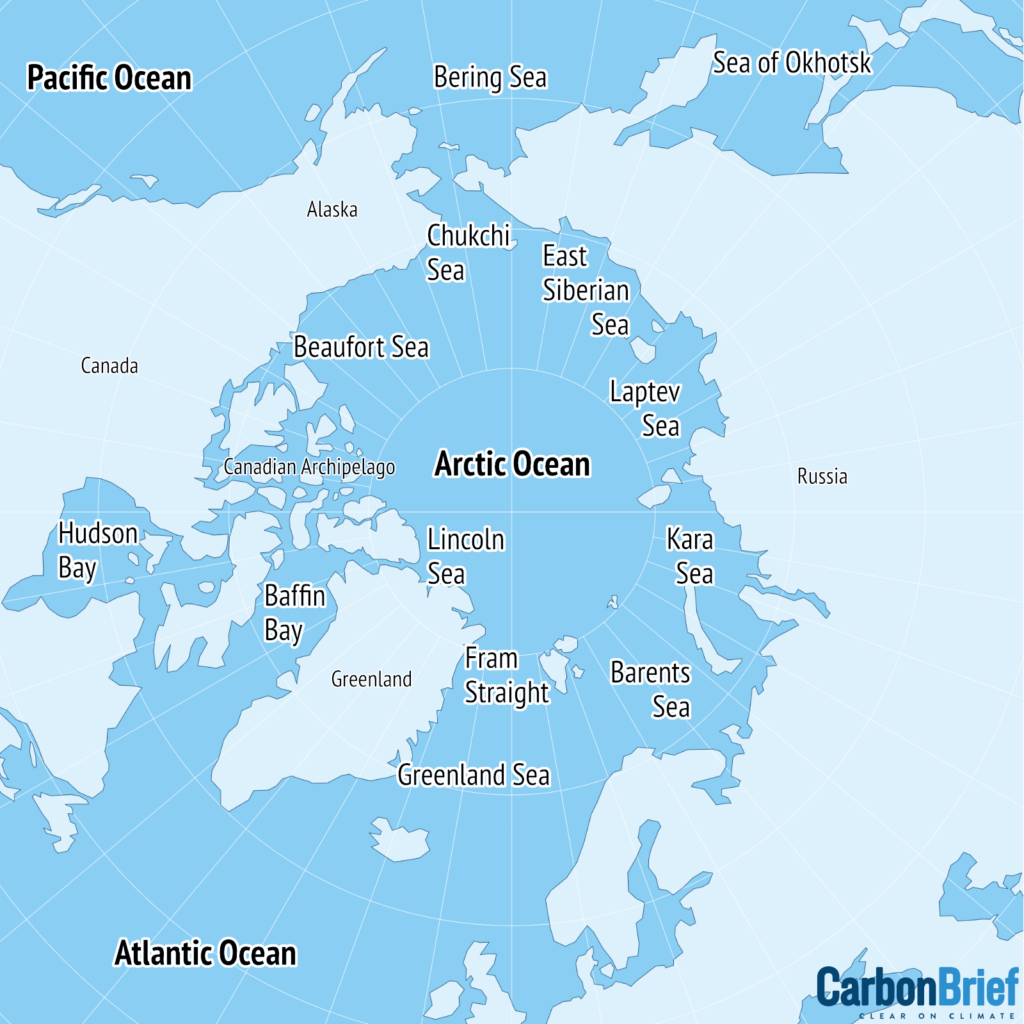
The NSIDC says that although average global temperatures in April were at a record high, temperatures in the Arctic were “well below average” by up to 3-5C in some regions.
“This May, early ice loss in the eastern part of Hudson Bay was striking,” the NSIDC says. Usually, the Hudson Bay is “nearly completely ice covered through May”, it adds. However, this year saw unusually “strong and persistent” winds from the east push ice from the eastern coast into open water, resulting in record low sea ice extent in the Hudson Bay.
The NSIDC notes that by 1 June 2024, sea ice extent in the Hudson Bay was 205,000km2 below the 1981-2010 average – 65,000km2 below the previous record low set in 2015.
Arctic sea ice extent in June retreated more slowly than usual and, by the end of the month, it was “tracking above all years since 2012 except for 2013 and 2015”, it adds.
July is the warmest month in the Arctic and sees the most rapid sea ice loss, the NSIDC says. It finds that Arctic sea ice “retreated rapidly” in July. The region lost 113,000km2 of ice per day throughout the month – faster than the 1981-2010 average pace of 87,000km2 per day.
Ice loss during the month was greatest in the Kara and East Siberian Seas, Baffin Bay, Hudson Bay, and the Canadian Archipelago, the NSIDC says. Meanwhile, unusually for the time of year, a small patch of ice remained in the Hudson Bay by the end of the month. It adds that air temperatures were near average overall, with several areas slightly cooler than average.
By the end of July, Arctic sea ice extent was the third-lowest extent in the 46-year satellite record by the end of the month. Rapid Arctic ice loss continued into the first week of August, and by mid-August, sea ice extent was the fourth lowest on record, the NSIDC says.
The graphic below shows Arctic sea ice extent between 1978 and 2024, where red indicates the 2024 extent and shades of blue indicate different years over 1978-2023, where darker colours indicate more recent years.
Throughout August, ice loss slowed down in response to “waning sunlight and decreasing air temperatures”, as is typical for this time of year, the NSIDC says. By the end of August, Arctic sea ice extent was 4.55m km2 – the fourth lowest in the satellite record.
The map below shows Arctic sea ice average extent for September 2024, where the pink line shows the 1981-2010 average.
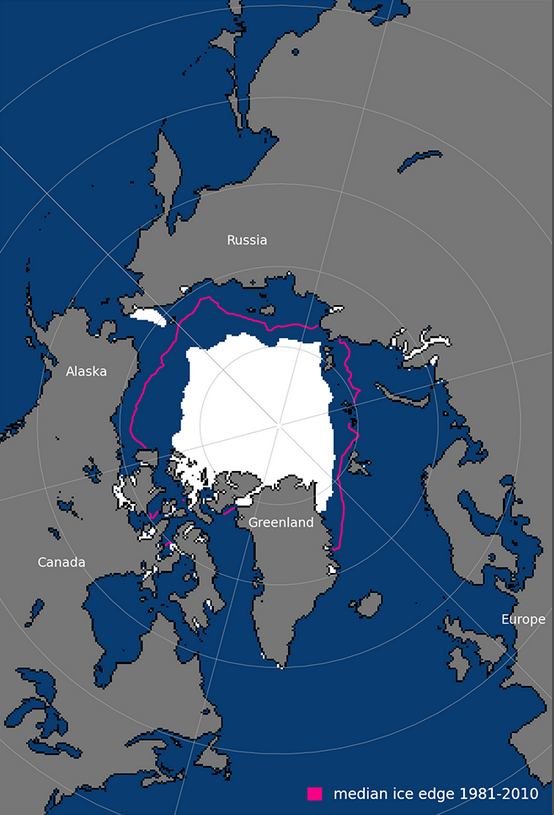
Arctic sea ice reached its annual minimum extent of 4.28m km2 on 11 September 2024, ranking as the seventh lowest in the 46-year satellite record.
The NSIDC adds that “the last 18 years are the lowest 18 Arctic sea ice extents in the satellite record”.
On thin ice
Labe tells Carbon Brief that Arctic sea ice this year has been “unusually thin”, explaining that the Arctic has seen “unusually low sea-ice concentration with the ice being more spread out and with more areas of open water found between the ice floes”.
This has resulted in near record-low total Arctic sea ice volume.
Prof Alexandra Jahn is an associate professor at the University of Colorado’s Institute of Arctic and Alpine Research. She tells Carbon Brief that natural variability has contributed to the observed loss of ice – “especially during the early 21st century”.
However, she adds that internal variability alone cannot completely explain the extent of the loss we have seen, and human-caused greenhouse gas emissions “are required to get an Arctic sea ice loss as large as observed”.



![Zack Labe on X/Twitter (@ZLabe): There was an accelerated loss of sea ice volume last month in the #Arctic. We are not far from a record low. Each line represents one year from 1979 [dark blue] to 2023 [dark red]. This year is shown in yellow - now updated through all of August 2024](https://www.carbonbrief.org/wp-content/uploads/2024/10/x.com_ZLabe_status_1833478263001518490-2.png)
